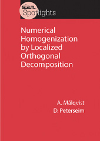- About MAA
- Membership
- MAA Publications
- Periodicals
- Blogs
- MAA Book Series
- MAA Press (an imprint of the AMS)
- MAA Notes
- MAA Reviews
- Mathematical Communication
- Information for Libraries
- Author Resources
- Advertise with MAA
- Meetings
- Competitions
- Programs
- Communities
- MAA Sections
- SIGMAA
- MAA Connect
- Students
- MAA Awards
- Awards Booklets
- Writing Awards
- Teaching Awards
- Service Awards
- Research Awards
- Lecture Awards
- Putnam Competition Individual and Team Winners
- D. E. Shaw Group AMC 8 Awards & Certificates
- Maryam Mirzakhani AMC 10 A Awards & Certificates
- Two Sigma AMC 10 B Awards & Certificates
- Jane Street AMC 12 A Awards & Certificates
- Akamai AMC 12 B Awards & Certificates
- High School Teachers
- News
You are here
Numerical Homogenization by Localized Orthogonal Decomposition

Publisher:
SIAM
Publication Date:
2020
Number of Pages:
108
Format:
Paperback
Price:
$44.00
ISBN:
978-1-611976-44-1
Category:
Monograph
[Reviewed by , on ]
Bill Satzer
01/24/2021
This short monograph introduces the method of Localized Orthogonal Decomposition for solving partial differential equations that model systems with components that are present at different size and distance scales. The book is clearly aimed at specialists with strong backgrounds in partial differential equations and numerical analysis.
The motivation for work like this is the desire to model physical processes in micro-heterogeneous materials such as modern composite and multifunctional materials. Many composites consist of nonhomogeneous materials with a matrix containing reinforcement elements such as particles and fibers. When a material like this begins to fail, the failure begins in the microstructure and then propagates on larger scales until complete failure occurs. Similar situations occur both in manufactured materials and in natural environments such as geological structures and groundwater flow.
It is not feasible to build computational tools for physical systems like these at each distance scale from micro to macro levels and combine the results. The idea of homogenization is to build an approximate model that is roughly equivalent to the physical system without representing the details of the individual microstructures. In the past finite element modeling with homogenization has been used to evaluate structural properties of materials consisting of microstructural periodic composites using an asymptotic expansion of the governing equations to bridge the micro-to-macro scales with an averaging process. In doing this there is an assumption that there is a representative volume element (a unit cell with a very small microstructure compared with the overall macroscopic structure of interest) that is locally repeated.
The authors’ aim is to develop a local version of the orthogonal decomposition method that has been used to compute numerical solutions of partial differential equations and then apply it in the context of homogenization methods. They begin with a one-dimensional elliptic PDE example that demonstrates why basic finite element methods are inadequate and how homogenization is especially effective for problems with periodicity and multiple scales.
Multidimensional problems without periodicity are a good deal harder, and the subject of much of the remainder of the book. There is a rigorous treatment of error analysis and an extended discussion of a basic implementation of Localized Orthogonal Decomposition in MATLAB.
The authors provide very limited background material, so the implicit assumption is that readers are already conversant with the basic subject matter, and are looking for more effective techniques.
Bill Satzer (bsatzer@gmail .com), now retired from 3M Company, spent most of his career as a mathematician working in industry on a variety of applications ranging from speech recognition and network modeling to optical films, material science and the odd bit of high performance computing. He did his PhD work in dynamical systems and celestial mechanics.
See the publisher's website.
- Log in to post comments




